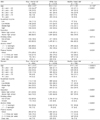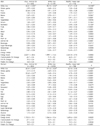1. Pasiakos SM, Margolis LM, Orr JS. Optimized dietary strategies to protect skeletal muscle mass during periods of unavoidable energy deficit. FASEB J. 2015; 29(4):1136–1142.

2. Lang T, Streeper T, Cawthon P, Baldwin K, Taaffe DR, Harris TB. Sarcopenia: etiology, clinical consequences, intervention, and assessment. Osteoporos Int. 2010; 21(4):543–559.

3. Wolfe RR. The underappreciated role of muscle in health and disease. Am J Clin Nutr. 2006; 84(3):475–482.

4. Barbat-Artigas S, Plouffe S, Pion CH, Aubertin-Leheudre M. Toward a sex-specific relationship between muscle strength and appendicular lean body mass index? J Cachexia Sarcopenia Muscle. 2013; 4(2):137–144.

5. Hughes VA, Frontera WR, Roubenoff R, Evans WJ, Singh MA. Longitudinal changes in body composition in older men and women: role of body weight change and physical activity. Am J Clin Nutr. 2002; 76(2):473–481.

6. Poggiogalle E, Lubrano C, Sergi G, Coin A, Gnessi L, Mariani S, et al. Sarcopenic obesity and metabolic syndrome in adult Caucasian subjects. J Nutr Health Aging. 2016; 20(9):958–963.

7. Cermak NM, Res PT, de Groot LC, Saris WH, van Loon LJ. Protein supplementation augments the adaptive response of skeletal muscle to resistance-type exercise training: a metaanalysis. Am J Clin Nutr. 2012; 96(6):1454–1464.

8. Kalyani RR, Tra Y, Egan JM, Ferrucci L, Brancati F. Hyperglycemia is associated with relatively lower lean body mass in older adults. J Nutr Health Aging. 2014; 18(8):737–743.

9. Shad BJ, Wallis G, van Loon LJ, Thompson JL. Exercise prescription for the older population: the interactions between physical activity, sedentary time, and adequate nutrition in maintaining musculoskeletal health. Maturitas. 2016; 93:78–82.

10. Lee CG, Boyko EJ, Strotmeyer ES, Lewis CE, Cawthon PM, Hoffman AR, et al. Association between insulin resistance and lean mass loss and fat mass gain in older men without diabetes mellitus. J Am Geriatr Soc. 2011; 59(7):1217–1224.

11. Kawanishi N, Takagi K, Lee HC, Nakano D, Okuno T, Yokomizo T, et al. Endurance exercise training and high-fat diet differentially affect composition of diacylglycerol molecular species in rat skeletal muscle. Am J Physiol Regul Integr Comp Physiol. 2018; 314(6):R892–R901.

12. Reidy PT, Rasmussen BB. Role of ingested amino acids and protein in the promotion of resistance exercise-induced muscle protein anabolism. J Nutr. 2016; 146(2):155–183.

13. Kim KM, Jang HC, Lim S. Differences among skeletal muscle mass indices derived from height-, weight-, and body mass index-adjusted models in assessing sarcopenia. Korean J Intern Med. 2016; 31(4):643–650.

14. Jang BY, Bu SY. Total energy intake according to the level of skeletal muscle mass in Korean adults aged 30 years and older: an analysis of the Korean National Health and Nutrition Examination Surveys (KNHANES) 2008-2011. Nutr Res Pract. 2018; 12(3):222–232.

15. Jang BY, Bu SY. A vegetable and fish dietary pattern is positively associated with skeletal muscle mass in Korean men. Clin Nutr Res. 2019; 8(1):1–16.
16. Reedy J, Wirfält E, Flood A, Mitrou PN, Krebs-Smith SM, Kipnis V, et al. Comparing 3 dietary pattern methods--cluster analysis, factor analysis, and index analysis--with colorectal cancer risk: the NIH-AARP Diet and Health Study. Am J Epidemiol. 2010; 171(4):479–487.

17. Song YJ, Paik HY, Joung HJ. A comparison of cluster and factor analysis to derive dietary patterns in Korean adults using data from the 2005 Korea National Health and Nutrition Examination Survey. Korean J Community Nutr. 2009; 14(6):722–733.
18. Tian HY, Qiu R, Jing LP, Chen ZY, Chen GD, Chen YM. Alternate Mediterranean diet score is positively associated with skeletal muscle mass index in middle-aged adults. Br J Nutr. 2017; 117(8):1181–1188.

19. Kim J, Yu A, Choi BY, Nam JH, Kim MK, Oh DH, Yang YJ. Dietary patterns derived by cluster analysis are associated with cognitive function among Korean older Adults. Nutrients. 2015; 7(6):4154–4169.

20. Song SJ, Lee JE, Paik HY, Park MS, Song YJ. Dietary patterns based on carbohydrate nutrition are associated with the risk for diabetes and dyslipidemia. Nutr Res Pract. 2012; 6(4):349–356.

21. Studenski SA, Peters KW, Alley DE, Cawthon PM, McLean RR, Harris TB, et al. The FNIH sarcopenia project: rationale, study description, conference recommendations, and final estimates. J Gerontol A Biol Sci Med Sci. 2014; 69(5):547–558.

22. Korea Centers for Disease Control and Prevention. Guidelines for utilization of raw data from the fifth Korea National Health and Nutrition Examination Survery (2010–2012). Cheongju: Korea Centers for Disease Control and Prevention;2012.
23. Song YJ, Paik HY, Yu CH. Factors affecting bone mineral density by dietary pattern group for some Korean college women. Korean J Nutr. 2006; 39(5):460–466.
24. Song YJ, Joung HJ, Paik HY. Socioeconomic, nutrient, and health risk factors associated with dietary patterns in adult populations from 2001 Korean National Health and Nutrition Survey. Korean J Nutr. 2005; 38(3):219–225.
25. Jahns L, Baturin A, Popkin BM. Obesity, diet, and poverty: trends in the Russian transition to market economy. Eur J Clin Nutr. 2003; 57(10):1295–1302.

26. Murayama N, Ishida H, Yamamoto T, Hazano S, Nakanishi A, Arai Y, et al. Household income is associated with food and nutrient intake in Japanese schoolchildren, especially on days without school lunch. Public Health Nutr. 2017; 20(16):2946–2958.

27. Kim M, Chung W, Lim S, Yoon S, Lee J, Kim E, et al. Socioeconomic inequity in self-rated health status and contribution of health behavioral factors in Korea. J Prev Med Public Health. 2010; 43(1):50–61.

28. Chanet A, Verlaan S, Salles J, Giraudet C, Patrac V, Pidou V, et al. Supplementing breakfast with a Vitamin D and leucine-enriched whey protein medical nutrition drink enhances postprandial muscle protein synthesis and muscle mass in healthy older men. J Nutr. 2017; 147(12):2262–2271.

29. Welch AA, Kelaiditi E, Jennings A, Steves CJ, Spector TD, MacGregor A. Dietary magnesium is positively associated with skeletal muscle power and indices of muscle mass and may attenuate the association between circulating C-reactive protein and muscle mass in women. J Bone Miner Res. 2016; 31(2):317–325.

30. Kim J, Jo I, Joung H. A rice-based traditional dietary pattern is associated with obesity in Korean adults. J Acad Nutr Diet. 2012; 112(2):246–253.

31. Ministry of Health and Welfare. The Korean Nutrition Society. Dietary reference intakes for Koreans 2015. Sejong: Ministry of Health and Welfare, The Korean Nutrition Society;2015.
32. Robinson SM, Jameson KA, Batelaan SF, Martin HJ, Syddall HE, Dennison EM, et al. Diet and its relationship with grip strength in community-dwelling older men and women: the Hertfordshire cohort study. J Am Geriatr Soc. 2008; 56(1):84–90.

33. Willet W. Nutritional epidemiology. 3th edition. Oxford: Oxford University Press;2012.
34. Hu FB. Dietary pattern analysis: a new direction in nutritional epidemiology. Curr Opin Lipidol. 2002; 13(1):3–9.








 PDF
PDF ePub
ePub Citation
Citation Print
Print





 XML Download
XML Download